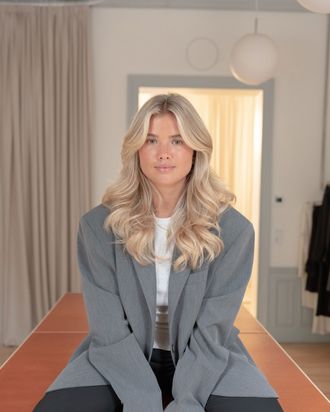
Just last month, fans of Matilda Djerf were lined up around the block, eager to try on pieces from her brand, Djerf Avenue. The Swedish company has gained immense popularity on the internet for its nonseasonal ready-to-wear pieces, including classic button-ups, blazers, and trousers. The items make for great basics, and we loved them. But recently, the internet has started calling Djerf out.
Why Is Djerf Being Called Out?
This began when creators who post dupes for Djerf Avenue pieces, such as a printed pajama set, started noticing their videos being flagged with trademark warnings. Over the weekend, Djerf and her team allegedly began copyright-striking small creators’ accounts to have videos taken down. One creator, Aliya Sumar, posted a TikTok showing that she had received trademark warnings from Djerf against two of her videos. In the post, Sumar claims she didn’t even refer to the pieces as dupes and told her followers the Djerf items were of better quality than the Amazon ones she found. Following this, Djerf Avenue posted to its TikTok and Instagram Story, “Unfortunately, there has been a recent surge in websites selling products with our design and owned prints/artworks. In light of this, and to safeguard our prints and the individual print designers — we have an external intellectual property (IP) firm monitoring copyright infringements.” Djerf said she is reaching out to creators and small businesses individually.
Why Did Calling Out Dupes … Backfire?
For one, dupes aren’t a new thing; creators find them for everything from perfumes to jewelry. It’s a way to access products that are borderline the same but usually sell at a more affordable price. (Djerf’s price point is $44 to $296.) The problem is that people online are calling Djerf out for thinking she has invented a certain type of look: “clean-girl Scandinavian style,” as her fans describe it. “She acts like she owns the style even though it’s been a thing in Scandinavia,” one comment on TikTok read. Her line consists of pieces of clothing that fans are saying existed before she launched her brand — for example, a vintage trench that she reimagined as a trench for her own brand. While this is not uncommon in fashion and everything quite literally comes from somewhere, it feels ironic to then turn around and try to take down others for the same act. Djerf apparently deactivated her TikTok following the controversy, though the brand page is currently still live.
What Is Clean-Girl Scandinavian Style, Anyway?
Clean-girl Scandinavian style is what has helped propel Djerf and other designers like Elsa Hosk and Emili Sindlev into popularity. Whole Instagram accounts are dedicated to the corner of the internet defined by roomy jeans, spirited knits, flip-flops, and an effortlessness that can come only from having universal health care. Danya Issawi, our fashion news writer, traveled to Copenhagen earlier this year and described the trends that prevail there. Which brings us back to Djerf: If you are profiting from an aesthetic that already exists, how can you call out others who are doing the same? And sure, there are proprietary laws that protect specific designs — which Djerf says protect her prints — but most of Djerf’s pieces are quite simple.
When Did Djerf Rise to Fame?
Djerf launched her brand in 2019, and it took off almost immediately. The direct-to-consumer model of selling straight from her Instagram grew so quickly that by 2022 Djerf was a household name. More than anything, she was selling a lifestyle: one of morning coffee in Swedish countryside cottages, hygge afternoons spent under quilts, and lots of cute puppies. Djerf herself was the product, which makes perfect sense for why people would want to buy into it. But it’s also what confused people about her allegedly trying to take down small creators when she started as one herself.





